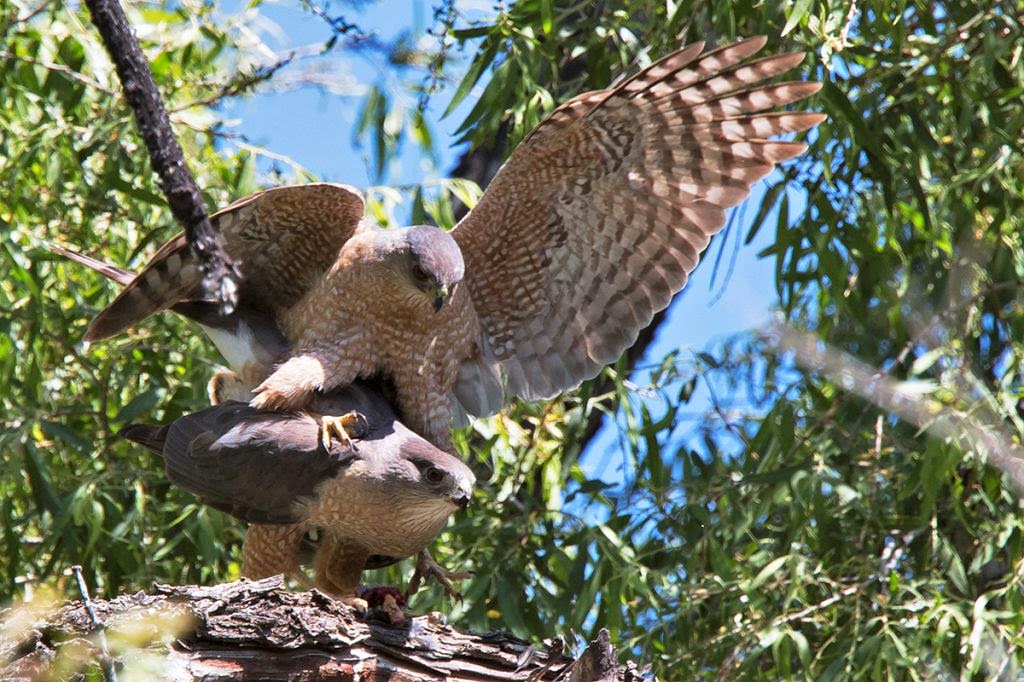 |
| Photo by Ned Harris 4/11/2015 |
Get up close and personal with hummingbirds by stopping by at a banding session in Sabino Canyon and/or on Mt Lemmon. Take a look at the project description, sites, and dates.
 |
| Photo by Ned Harris 4/11/2015 |
For several weeks in spring, the Tucson area is aglow with blooming Palo Verdes, our official state tree. Three species are found in Sabino Canyon, Blue (Parkinsonia florida), Foothill or Little-leaf (Parkinsonia microphylla) and the less common Mexican Palo Verde (Parkinsonia aculeate). It is thought the Mexican Palo Verde was introduced into Sabino. The two main species bloom at slightly different times, with the Blue reaching its peak at the end of March this year and the Foothill peaking in mid-April. These trees have probably evolved that way so they aren't competing as much for the pollinators. Through most of the year we differentiate the species by leaflet sizes, color of bark, and stiffness of the branches. However at this time of year we can easily distinguish species by the flowers.
 |
| Photo by Fred Heath 4/4/2015 |
The Blue Palo Verde has the five petals typical of a member of the pea family and all petals are bright yellow.
 |
| Photo by Fred Heath 4/4/2015 |
The Foothill Palo Verde has a similar shaped flower, but note that banner (the top petal) is white and the other four petals are more of a pale lemon yellow.
 |
| Photo by Fred Heath 4/11/2015 |
The Mexican Palo Verde flower is bright yellow with an orange banner petal. The Mexican Palo Verde has extremely long leaves with tiny leaflets which give the tree a more open look, probably why it is a favorite of the local horticulturists.
 |
| Photo by Fred Heath 4/17/2015 |
 |
| Photo by Marty Horowitz 4/10/2015 |
 |
| Photo by Ned Harris 4/11/2015 |
 |
| Photo by Marty Horowitz 4/14/2015 |
 |
| Photo by Marty Horowitz 4/10/2015 |
 |
| Photo by Marty Horowitz 4/17/2015 |
 |
| Photo by Ned Harris 4/11/2015 |
 |
| Photo by Ned Harris 4/11/2015 |
 |
| Photo by Ned Harris 4/11/2015 |
 |
| Photo by Ned Harris 4/11/2015 |
 |
| Photo by Ned Harris 4/11/2014 |
 |
| Photo by Marty Horowitz 4/12/2015 |
 |
| Photo by Marty Horowitz 4/12/2015 |
 |
| Photo by Marty Horowitz 4/8/2015 |
 |
| Photo by Marty Horowitz 4/10/2015 |
 |
| Photo by Ned Harris 3/29/2015 |
 |
| Photo by Marty Horowitz 4/8/2015 |
 |
| Photo by Ned Harris 4/11/2015 |
 |
| Photo by Marty Horowitz 4/8/2015 |
 |
| Photo by Marty Horowitz 4/10/2015 |
 |
| All Photos by Marty Horowitz 4/8/2015 |
 |
| All Photos by Marty Horowitz 4/14/2015 |
| All Photos by Matt Ball 4/8/2015 |
| Another photo by Matt Ball 4/8/2015 |
 |
| Photos by Bob Wenrick 3/25/2015 |
 |
| "I'm really a Red-spotted Purple." |
| Photo by Matt Ball 4/5/2015 |
| Photo by Matt Ball 4/8/2015 |
I think the male is the bottom one. He landed first and began to eat. She came later to try and get at some of the food. There is an active nest nearby. Last year there were 3 or 4 babies at a nearby nest.
 |
| Photo by Bill Kaufman 4/6/2015 |
 |
| Photo by Ned Harris 3/25/2015 |
| Photos by Matt Ball 4/5/2015 |
 |
| Photos by Marty Horowitz 4/10/2015 |
 |
| Photo by Ned Harris 3/29/2015 |